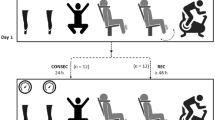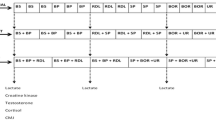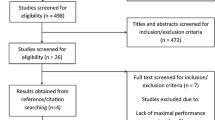Abstract
Objectives
External Counterpulsation (ECP) is a well-established treatment for coronary disease, with interest growing in the potential to act as a sports recovery modality or pre-performance strategy. This pilot study compared the effects of different ECP durations upon neuromuscular function (NF), cortisol and subjective perceptions in a rested state.
Methods
Eleven physically active male volunteers received two ECP treatments (Renew Sport, Singapore) of differing duration (20-min and 40-min) in a randomised, repeated measures crossover design. Testing occurred pre-ECP, post-ECP, and 24-h post-ECP. NF testing comprised counter-movement jumps (CMJs) and 6-s sprint cycling. Saliva samples were analysed for cortisol. Rate of Perceived Exertion (RPE, 6 to 20) and Bipolar Comfort Scales (− 10 to 10) quantified participants’ experiences, and ECP duration preference was examined. Repeated measures ANOVA and effect size (ES: Cohen’s d) analysed NF and cortisol results. Paired t-tests analysed RPE and comfort ratings.
Results
ECP demonstrated no effect, neither positive nor negative, upon NF outcome measures in both groups. A trend of reduced salivary cortisol levels across both groups following ECP was observed (P = 0.066). No RPE difference existed between groups. 20-min of ECP was rated as significantly more comfortable than 40-min (P < 0.05) and participants predominantly identified the 20-min ECP session as “more acceptable”.
Conclusions
These results indicate that there were no effects for either duration upon the defined outcome measures, and thus, in these circumstances, no differences between the two durations were observed with respect to effects upon NF and salivary cortisol. The use of ECP warrants further investigation for potential benefits to performance before it can be proposed as an effective preparatory modality.




Similar content being viewed by others
References
Ache Dias J, Dal Pupo JD, Reis DC, Borges L, Santos SG, Moro ARP, Borges NG Jr. Validity of two methods for estimation of vertical jump height. J Strength Cond Res. 2011;25(7):2034–9.
Bali A. Psychological factors affecting sports performance. Int J Phys Educ Sports Health. 2015;1(6):92–5.
Bini R, Hume PA, Croft JL. Effects of bicycle saddle height on knee injury risk and cycling performance. Sports Med. 2011;41(6):463–76.
Borg G. Perceived exertion as an indicator of somatic stress. Scand J Rehabil Med. 1970;2(2):92–8.
Casey DP, Conti CR, Nichols WW, Choi CY, Khuddus MA, Braith RW. Effect of enhanced external counterpulsation on inflammatory cytokines and adhesion molecules in patients with angina pectoris and angiographic coronary artery disease. Am J Cardiol. 2008;101:300–2.
Catanese CR. Effect of external counterpulsation (ECP) on delayed onset muscle soreness (DOMS) in long distance runners. (Master’s thesis) Cleveland State University, Cleveland, OH: 2007.
Collins R, McGrath D, Horner K, Eusebi S, Ditroilo M. Effect of external counterpulsation on exercise recovery in team sport athletes. Int J Sports Med. 2019;40(8):511–8.
Crewther BT, Thomas AG, Stewart-Williams S, Kilduff LP, Cook CJ. Is salivary cortisol moderating the relationship between salivary testosterone and hand-grip strength in healthy men? Eur J Sport Sci. 2017;17(2):188–94.
Fama BJ, Bueti DR. The acute effect of self-myofascial release n lower extremity plyometric performance (Master’s thesis). Sacred Heart University, Fairfield, CT; 2011
Haff G, Nimphius S. Training principles for power. SCJ. 2012;34(6):2–12.
Hernandez L, Alemood A, Genaidy AM, Karwowski W. Evaluation of different scales for measurement of perceived physical strain during performance of manual tasks. Int J Occup Saf Ergon. 2002;8:413–32.
Hopkins WG, Marshall SW, Batterham AM, Hanin J. Progressive statistics for studies in sports medicine and exercise science. Med Sci Sports Exerc. 2009;41(1):3–13.
Kelly V, Caia J, Roberts L, Scott T. Effects of external counter pulsation therapy on recovery following a rugby league match. Abstract presented at the 22nd annual Congress of the European College of Sports Science, Essen, Germany; 2017, July.
Kelly V, Roberts L, Scott T. Physiological and perceptual response to acute external counterpulsation therapy in elite athletes. J Sports Sci. 2016;34(S1):s74.
Kelly V, Roberts L, James L, Caia J, Scott T, Halson S. Effects of long-term external counterpulsation therapy on performance, recovery and systemic vascular adaptations in elite rugby league players. J Sports Sci. 2016;34(S1):s16.
Lindsay A, Costello JT. Realising the potential of urine and saliva as diagnostic tools in sport and exercise medicine. Sports Med. 2017;47:11–31.
Manchanda A, Soran O. Enhanced external counterpulsation and future directions. JAAC. 2007;50(16):1523–31.
Moran RN, Hauth JM, Rabena R. The effect of massage on acceleration and sprint performance in track & field athletes. Complement Ther Clin Prac. 2018;30:1–5.
Moraska A, Pollini RA, Boulanger K, Brooks MZ, Teitlebaum L. Physiological adjustments to stress measures following massage therapy: a review of the literature. Evid Based Complement Alternat Med. 2010;7(4):409–18.
Moyer CA, Seefeldt L, Mann ES, Jackley LM. Does massage therapy reduce cortisol? A comprehensive quantitative review. J Bodyw Mov Ther. 2011;15(1):3–14.
Nunes GS, Bender PU, de Menezes FS, Yamashitafuji I, Vargas VZ, Wageck B. Massage therapy decreases pain and perceived fatigue after ong-distance Ironman triathlon: a randomised trial. J Physiother. 2016;62(2):83–7.
Peterson AR, Smoot MK, Erickson JL, Mathiasen RE, Kregel KC, Hal M. Basic recovery aids: what’s the evidence? CSMR. 2015;14(3):227–34.
Pruscino CL, Halson S. Effects of compression garments on recovery following intermittent exercise. Eur J Appl Physiol. 2013;113(6):1585–96.
Ripley NJ, Grainger A, Comfort P. Comparison between a 6 second and 30 second cycle ergometer test for peak power in elite rugby union players. JASC. 2018;26(3):27–30.
Roberts L, James L, Caia J, Wellington B, Scott T, Halson S, Kelly V. Effects of external counterpulsation therapy on acute recovery in elite australian rugby league players. J Sci Med Sport. 2017;20:e85.
Russell S, Evans AG, Jenkins DG, Kelly VG. Effect of external counterpulsation on running performance and perceived recovery. IJSPP. 2020;15(7):920–6.
Strahorn J, Serpell BG, McKune A, Pumpa KL. Effect of physical and psychosocial interventions on hormone and performance outcomes in professional rugby union players: a systematic review. J Strength Cond Res. 2017;31(11):3158–69.
Valenzuela PL, Montalvo Z, Torrontegi E, Sánchez-Martínez G, Lucia A, de la Villa P. Enhanced external counterpulsation and recovery from a plyometric exercise bout. Clin J Sport Med. 2018; Advance online publication. https://doi.org/10.1097/jsm.0000000000000620.
Valenzuela PL, Sánchez-Martínez G, Torrontegi E, Zigor M, Lucia A, de la Villa P. Enhanced external counterpulsation and short-term recovery from high intensity interval training. IJSPP. 2018;13(8):1100–6.
Wehbe G, Gabett TJ, Dwyer D, McLellan C, Coad S. Monitoring neuromuscular fatigue in team-sport athletes using a cycle-ergometer test. IJSPP. 2015;10(3):292–7.
Werner D, Kropp J, Schellong S, Friedel C, Voigt JU, Ludwig J, Flachskampf FA. Practicability and limitations of enhanced external counterpulsation as an additional treatment for angina. Clin Cardiol. 2003;26(11):525–9.
Acknowledgements
This study was supported by funding and equipment from Renew Health Limited (grant V1360). The authors would like to thank:—the UCD Institute for Sport and Health, and its director Prof. Boreham, for providing logistical support—Katie Coffey, for her assistance with recruitment of participants and data collection—all the participants for their time and effort.
Author information
Authors and Affiliations
Corresponding author
Ethics declarations
Conflict of interest
The authors declare that they have no conflicts of interest.
Rights and permissions
About this article
Cite this article
Collins, R., Ditroilo, M., Horner, K. et al. A Comparison of the Effect of 20- and 40-Min Session Durations of External Counterpulsation on Neuromuscular Function, Cortisol and Comfort in Physically Active Young Men. J. of SCI. IN SPORT AND EXERCISE 3, 138–146 (2021). https://doi.org/10.1007/s42978-021-00109-1
Received:
Accepted:
Published:
Issue Date:
DOI: https://doi.org/10.1007/s42978-021-00109-1




